
191
HNUE JOURNAL OF SCIENCE
Educational Sciences 2024, Volume 69, Issue 5B, pp. 191-200
This paper is available online at http://hnuejs.edu.vn/es
DOI: 10.18173/2354-1075.2024-0147
INTEGRATING MATHEMATICS AND ECONOMICS WITH THE SUPPORT
OF GEOGEBRA SOFTWARE IN TEACHING THE SYSTEM OF FIRST-ORDER
INEQUALITIES WITH TWO UNKNOWNS AT THE HIGH SCHOOL LEVEL
Nguyen Ngoc Giang1,*, Pham Huyen Trang2, Nguyen Thi Nga3, Ho Loc Thuan4
and Mai Vu Linh Dan5
1Faculty of Data Science in Business, Ho Chi Minh University of Banking,
Ho Chi Minh city, Vietnam
2Faculty of Primary Education, Hanoi Pedagogical University 2, Vinh Phuc province, Vietnam
3Faculty of Mathematics - Informatics, Ho Chi Minh City University of Education,
Ho Chi Minh city, Vietnam
4Practical High School, Saigon University, Ho Chi Minh city, Vietnam
5Duong Van Thi High School, Thu Duc city, Vietnam
*Corresponding author: Nguyen Ngoc Giang, e-mail: giangnn@hub.edu.vn
Received May 6, 2024. Revised September 20, 2024. Accepted December 27, 2024.
Abstract. The 2018 General Education Curriculum has introduced numerous innovative
teaching methods including integrated teaching. Within the context of integrated teaching,
interdisciplinary integration is among the teaching methods that have drawn significant
attention. Meanwhile, the content of the system of first-order inequalities with two unknowns
is a crucial topic in mathematics, potentially enhancing the integrated teaching methods. This
study introduces a new teaching approach that integrates interdisciplinary teaching of
mathematics and economics with the support of GeoGebra software in teaching the system
of first order inequalities with two unknowns at the high school level. Building on existing
research on integrated teaching, the research team employs both theoretical and practical
research methods to develop a teaching approach tailored to the current educational context
in Vietnam. The research has identified two approaches for exploiting, providing the teaching
process as well as outlining methods to organize interdisciplinary teaching of mathematics
and economics through economics problems about the system of first-order inequalities with
two unknowns. The research focus of the article represents a significant contribution to
enhancing the quality of teaching and learning.
Keywords: integrated teaching, interdisciplinary, system of first-order inequalities with two
unknowns, mathematics, GeoGebra, economics.
1. Introduction
Over the past 5 years, since the introduction of the 2018 General Education curriculum,
numerous new teaching methods have emerged, among which integrated teaching is the teaching
method that garnered significant attention from many educators. Previously, the curriculum was
organized in isolation. However, the approach of teaching subjects in isolation presents a
significant challenge in education, preventing students from recognizing and connecting

Nguyen NG*, Pham HT, Nguyen TN, Ho LT & Mai VLD
192
knowledge and skills between subjects [1], [2]. Integration in teaching gives students the
opportunity to experience and see the connection as well as the interrelationship between different
contents of a particular curriculum [3].
Interdisciplinary integrative teaching is an approach that proposes situations that can only be
logically approached through the illumination of multiple disciplines. In other words, subjects are
integrated to solve a given situation. The learning processes will not be mentioned in isolation but
must be linked together around the problems to be solved [4], making learning meaningful
regardless of the student's grade level [5].
Numerous studies have been conducted on integrated teaching and interdisciplinary
integration. However, interdisciplinary integrated teaching of mathematics and economics for the
problem of the system of first-order inequalities with two unknowns in high school has not been
mentioned in any works. Therefore, the introduction of a teaching method that integrates
mathematics and economics for the problem of the system of first-order inequalities with two
unknowns is a gap that needs to be filled in by researchers in our country. In order to fill the gap,
the authors conducted research focusing on key issues, including the theoretical foundations of
the integrated teaching perspective, interdisciplinary integration, integrated classification,
comparisons between integrated teaching and traditional methods, teaching strategies that
integrate mathematics and economics, the teaching process that incorporates mathematics and
economics through specific problems, and the organizational structure for teaching according to
this approach.
2. Content
2.1. Different views on integrated teaching
Integrated teaching encompasses a variety of views and perspectives. The term “integrated”
is derived from the Latin word, which means the coordination of different activities to ensure
harmonious functioning. Integration is best demonstrated by our own bodies, where many
different systems exist and all work in synchronicity and rhythm. Integrated teaching is defined
as the organization of teaching content of each separate subject connected into a unified whole [6].
In the educational aspect, integration is the process of making connections between skills
and knowledge from resources and teaching experiences. It is the connection between theory and
practice as well as the use of different perspectives to help students understand the problem
comprehensively [7]. This is an activity that helps students connect old and new knowledge and
understand the connections in the curriculum [8].
In 2019, in a study addressing the integration of mathematics, information science, and
physics, we proposed a definition of integration. Integrating an object or phenomenon within a
subject involves connecting that object or phenomenon to related phenomena, as well as
identifying internal connections within the object itself. This integration forms a cohesive and
meaningful unit within a specific context [9].
An essential skill of the 21st century is how to make sense of today's enormous and highly
complex information. For this reason, it is important for students to develop the ability to connect
scattered information. Thinking that combines scattered information can be defined as integrative
thinking [10].
Integration is a teaching method that helps learners discover, collect, process, filter, and
present information on related topics, the process of making connections between existing
concepts and experiences in order to receive new information and successfully solve new
problems [6].

Integrating mathematics and economics with the support of GeoGebra software in teaching the system…
193
From the aforementioned definitions, it is evident that integration represents a learning model
that connects distributed information with both prior and newly acquired knowledge. However, it is
not just about connecting scattered information but the unification between different parts to
create a complete block to make learning complete, valuable, and stimulating student learning. In
addition, integration depends on the cultural environment and the context of the teaching activity.
People in one particular region will have a different way of receiving integrated teaching from
those in other regions. People in one certain century will have a different approach to integrated
teaching than people in other centuries. Referring to integration, we need to associate it with
certain areas: Which historical period? Which learning society? No form of integration exists
independently; it is invariably tied to institutions, social contexts, and cultural backgrounds.
2.2. Classification of integrated teaching
Integration can be classified in many different ways. In terms of subject content, there are
four approaches. The first is esoteric integration. This integrated approach is taught in pursuit of
the proposed integration goals, prioritizing the content of each subject. The second type is
integration from a transdisciplinary point of view. The content develops competencies common
to many subjects, called transdisciplinary competencies. The third is integration from an
interdisciplinary point of view (integrate interdisciplinary teaching), also known as inter-subject
integration. The content is the application of information from a variety of subjects to solve a
problem. The fourth type of integration is viewed from a multidisciplinary perspective, where
content is examined through the lenses of various disciplines. For example, the same content of a
system of first-order inequalities with two unknowns can be studied in terms of mathematics,
computer science, or economics [4].
In terms of integration, there are two approaches: horizontal integration and vertical
integration. Horizontally integrated teaching is the organization of subject topics across a given
period. In this teaching process, students integrate two or more subjects in the transmission of
curriculum knowledge. In other words, horizontal integration is two or more subjects taught
simultaneously. These subjects are taught in a unified way, not separately. Vertically integrated
teaching is a way of organizing topics between different subjects over an indefinite period. In this
teaching process, students integrate two or more subjects in different phases of the curriculum. In
other words, vertical integration is the integration between subjects traditionally taught in
different phases of the curriculum [6].
2.3. Compare integrated teaching with traditional teaching
On the basis of the work of Mathur et al [6], we have edited, supplemented, and made a
comparison table between integrated teaching and traditional teaching as follows:
Table 1. Comparison between integrated teaching and traditional teaching
Integrated teaching
Traditional teaching
Taught by many teachers of different
subjects at the same time or taught by a
teacher with professional expertise in
many different subjects.
Taught by a qualified teacher of a certain subject.
Do not repeat the teaching content too
much
Teaching content can be repeated in a spiral
pattern.

Nguyen NG*, Pham HT, Nguyen TN, Ho LT & Mai VLD
194
Time is better spent and more effective
than traditional teaching
Spending more time than integrated teaching
The connection in integrated teaching is
better than traditional teaching
The connection in the content is quite difficult
Stimulate thinking and improve the ability
to grasp knowledge
Knowledge cramming
Understand and absorb knowledge better.
Less knowledge absorption
The learning content is consistent with
each other
Learning content is separated by different high and
low levels
An approach that improves and develops
interest in the subject being studied
May discourage student learning
Clarify the concept more.
There is some confusion in the minds of students
about the subject.
Emphasis on understanding concepts and
current issues
Emphasis on testing and results
Less confusion when information is
distributed on the same platform
Different information on the same topic on
different platforms causes confusion in students’
minds.
Develop students' creativity.
No or little development in students' creativity
2.4. Concept of interdisciplinary integrated teaching of mathematics and economics
with the support of GeoGebra software
On the basis of the views on integration and interdisciplinary integration, we believe that the
combination of mathematics and economics, supported by GeoGebra software, involves
connecting knowledge, content, and methods from both fields to create a cohesive and
comprehensive approach to the problem. This unity and comprehensiveness is not merely a
mechanical addition of separate mathematical and economic components, but rather the formation
of a new field that illuminates both mathematics and economics through GeoGebra software. The
selected issue in interdisciplinary teaching, supported by GeoGebra software, must be relevant to
real-life situations, aligned with the Vietnamese social context, and connected to global
perspectives.
2.5. The advantages and limitations of interdisciplinary teaching
We compare the interdisciplinary teaching of mathematics and economics, supported by
GeoGebra software, in the context of teaching the system of first order inequalities with two
unknowns, examining both forward and reverse directions.

Integrating mathematics and economics with the support of GeoGebra software in teaching the system…
195
Table 2. Comparing teaching methods that integrate interdisciplinary teaching
of mathematics and economics supported by GeoGebra software in the context of teaching
the system of first order inequalities with two unknowns in the forward and reverse directions
Advantages
and limitations
Forward direction
Reverse direction
Advantages
The problem statement is tight
and realistic. There are no
artificial problems or
simulated realities, as all
referenced materials have
been evaluated and validated
by experts in mathematics and
economics.
Help exploit and expand the problem. The
same math problem can give rise to
multiple practical scenarios, allowing
students to develop creative thinking.
Limitations
The problem cannot be
expanded if this process is
strictly followed.
The emergence of a pseudo-realistic
problem or a simulation of reality, depends
on the mathematical model in use. In other
words, it is uncertain whether the
economic problem we have presented can
be translated into real-life situations.
2.6. Teaching process that integrates interdisciplinary teaching of mathematics and
economics supported by GeoGebra software in the context of teaching the system of
first order inequalities with two unknowns in high school
Building on the two teaching methods that integrate interdisciplinary teaching of
mathematics and economics with the support of GeoGebra software in teaching the system of
first-order inequalities with two unknowns at the high school level, we combine them into a
unified teaching process consisting of four steps:
Step 1. Find the economic problem of the system of first order inequalities with two unknowns
suitable for integrated teaching.
(An economics problem typically refers to a situation or question that involves the allocation
of resources, production, distribution, or consumption of goods and services).
Search in textbooks and references for problems that are often presented on systems of first-
order inequalities with two unknowns framed as economics problems, such as finding the largest
and smallest values of an objective function. These economics problems typically use common
terms that are not overly specialized, making them both accessible for students and practical for
teaching purposes. Teachers choose problems intentionally so that they can be developed and
expanded in an integrated direction.
Step 2. Solve the economic problem.
Model economics problems through mathematical frameworks. Use mathematical concepts
found in textbooks to solve problems related to finding the largest and the smallest objective
function. The objective function reaches its optimal value at the vertices of the polygon.
Step 3. Solve and verify economic problems with GeoGebra software
Use GeoGebra software to draw polygons. Create a Slider tool that moves the line
representing the objective function to different positions to identify the maximum or minimum


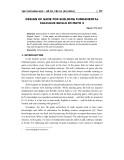

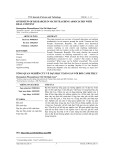



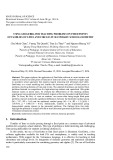
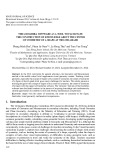
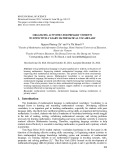

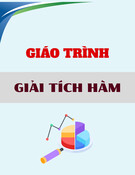
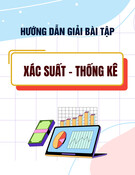
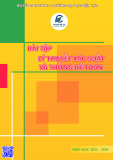
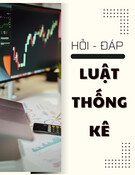
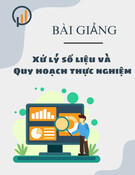
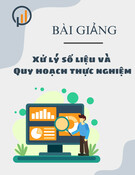
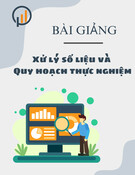
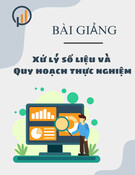
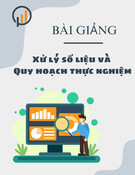
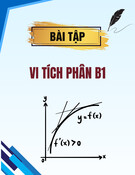
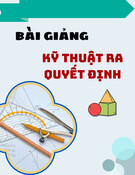
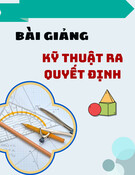
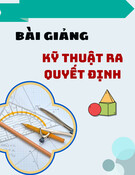
![Quyển ghi Xác suất và Thống kê [chuẩn nhất]](https://cdn.tailieu.vn/images/document/thumbnail/2025/20251030/anh26012006/135x160/68811762164229.jpg)
